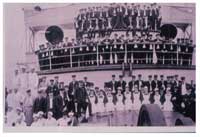The Increased Division of Labour: Emerging Occupations

 Growth in transatlantic passenger liner service around 1900, led to increased work for stewards, cooks, and waiters in the merchant marine as a whole (Burton 1985, 314). Unlike all other capacities aboard merchant ships filled solely by men, stewards' departments employed some women, though they remained a small minority, and received lower wages. Using Crew Agreements for large passenger liners held elsewhere than at Memorial, it is possible to compare the Arlanza's six stewardesses among 121 waiters and stewards in 1913 with the 23 female attendants, nursemaids, matrons, and stewardesses in a steward's department of over five hundred men on the Olympic in 1921 (Southampton City Record Office 132021; The National Archives, Britain TNA 100/440). The position of stewardess was created to assist female passengers, and to serve as nursemaids to children and women passengers' female companions. When the position was first offered to women, merchant ships were a strictly male dominated workplace (Riche, 35). Although stewardess work was similar to the work many women did for their families on shore, stewardesses earned a wage for their work. Among the fifty-person crew Among the fifty-person crew of the passenger liner Kastalia, which in June 1920 travelled from England to the United States, there were three women: Emily Leigh Douglas, Cornelia Brookfield and Marcel [Marcille?] L. Phillips (ON 141923, 1919, MHA). Work done by women in the Victorian and later Edwardian periods was generally considered inferior to that done by men. Pay for stewardesses, for instance, remained low, from between £2.10 and £3 a month (Riche 1994, 36). For Douglas, Brookfield and Phillips, their wages were even lower at 1s a month. None of these women made the return journey back to England—they disembarked in North America. Merchant ships often carried a small number of immigrants who paid their way across the North Atlantic with their labour.
Growth in transatlantic passenger liner service around 1900, led to increased work for stewards, cooks, and waiters in the merchant marine as a whole (Burton 1985, 314). Unlike all other capacities aboard merchant ships filled solely by men, stewards' departments employed some women, though they remained a small minority, and received lower wages. Using Crew Agreements for large passenger liners held elsewhere than at Memorial, it is possible to compare the Arlanza's six stewardesses among 121 waiters and stewards in 1913 with the 23 female attendants, nursemaids, matrons, and stewardesses in a steward's department of over five hundred men on the Olympic in 1921 (Southampton City Record Office 132021; The National Archives, Britain TNA 100/440). The position of stewardess was created to assist female passengers, and to serve as nursemaids to children and women passengers' female companions. When the position was first offered to women, merchant ships were a strictly male dominated workplace (Riche, 35). Although stewardess work was similar to the work many women did for their families on shore, stewardesses earned a wage for their work. Among the fifty-person crew Among the fifty-person crew of the passenger liner Kastalia, which in June 1920 travelled from England to the United States, there were three women: Emily Leigh Douglas, Cornelia Brookfield and Marcel [Marcille?] L. Phillips (ON 141923, 1919, MHA). Work done by women in the Victorian and later Edwardian periods was generally considered inferior to that done by men. Pay for stewardesses, for instance, remained low, from between £2.10 and £3 a month (Riche 1994, 36). For Douglas, Brookfield and Phillips, their wages were even lower at 1s a month. None of these women made the return journey back to England—they disembarked in North America. Merchant ships often carried a small number of immigrants who paid their way across the North Atlantic with their labour.
